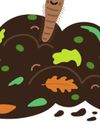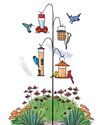Versuchen GOLD - Frei
Degrees of Hibernation
Birds & Blooms
|December 2021/January 2022
How garden visitors snooze away the coldest months.

Many backyard guests—such as monarchs and orioles-make for warmer climates as temperatures drop. The rest hunker down. How they prepare and where they lay their heads sometimes differ even within the same species. But no matter how they overwinter, they do it for the same reason: to conserve energy.
As days shorten, animals take the cue from Mother Nature and add layers of fat while food is more available. These reserves essentially act as a big bank of energy that animals draw from while they're in the deep-sleeping state of hibernation,” says Kevin Brunke, natural history biologist with the Missouri Department of Conservation.
To make those reserves last, animals lower their metabolism and body temperature and slow their heart rate and breathing. “They burn fewer calories while they wait for more favorable foraging opportunities to become available,” Kevin says.
Deep Sleepers
Hibernation champs include groundhogs, ground squirrels, meadow jumping mice and some species of bats. These bona fide hibernators remain in a state of inactivity for several days, weeks or months and can sleep through loud noises and other commotion.
Diese Geschichte stammt aus der December 2021/January 2022-Ausgabe von Birds & Blooms.
Abonnieren Sie Magzter GOLD, um auf Tausende kuratierter Premium-Geschichten und über 9.000 Zeitschriften und Zeitungen zuzugreifen.
Sie sind bereits Abonnent? Anmelden
WEITERE GESCHICHTEN VON Birds & Blooms

Birds & Blooms
Better Off with Bats
Rethink the unsung heroes of the night and why you should support them
2 mins
October / November 2025

Birds & Blooms
Late Bloomers to Love
Keep garden colors going strong with fall perennials
3 mins
October / November 2025

Birds & Blooms
IN THE COMPANY OF OWLS
On any given morning, you'll find A.J. Berard trekking through the woods and mountains of Montana with a 45-pound pack and his Siberian huskies.
3 mins
October / November 2025

Birds & Blooms
Tree TLC
Discover tips for planting and tending to trees, from the roots up
2 mins
October / November 2025

Birds & Blooms
EASY. BREEZY Black-Eyed Susans
Planting rudbeckia, with petals aglow in honeyed yellow, fiery orange and velvety burgundy, is like sprinkling sunshine throughout the garden.
3 mins
October / November 2025

Birds & Blooms
Social and Adaptable
Find out how the house finch became a backyard regular
1 mins
October / November 2025

Birds & Blooms
Tales from the UNDERSTORY
The dense forest floor is the perfect setting to nest and forage
3 mins
October / November 2025
Birds & Blooms
Tracking Tiny Travelers
Small, numbered rings reveal the secrets of hummingbird migration
2 mins
June/July 2025

Birds & Blooms
The Dirt on Millicompost
Learn how to use millipedes to increase soil health
2 mins
June/July 2025

Birds & Blooms
THE PERFECT PAIRING
Learn the best ways to use an abundance of blooms to attract more birds and beautify your feeder space
3 mins
June/July 2025
Translate
Change font size

